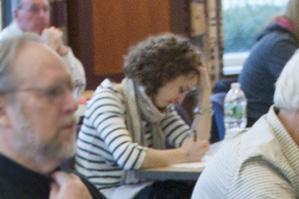Year in review, science style

Someone once told me that being a science writer is like being in school forever. Over the past year, my first at Northeastern, I have found that to be absolutely true. I have learned about the Higgs Boson from a particle physicist and the neurology of emotion from a psychologist. I have played video games designed to help arthritis patients and listened to a chemist play the viola in front of a nitrogen tank. I have gone to countless talks on everything from drug abuse research to the societal implications of language. Between visiting labs and hanging out with lobsters, this year has undoubtedly been one of the most educational of my life.
Before I decided to become a science writer, I toyed around with the idea of chemistry graduate school and visited labs all over town to see if any intrigued me enough to devote several years of my life to it. One researcher, who was at BU at the time, was looking for bacterial corollaries to human drug targets in order to repurpose shelved pharmaceuticals for neglected diseases. I thought this was pretty cool. Mike Pollastri’s work had been stuck in my head for years by the time I discovered he was now at Northeastern. His was first on my list of labs to visit.
It was also in the early part of the year that I first heard the term “network science,” which has since become a big part of my life. In January, Alessandro Vespignani delivered a lecture describing how he uses human mobility networks to map the spread of epidemic diseases across the globe and pretty much blew my mind. I later spoke to other researchers like Albert-László Barabási and David Lazer about how they look at networks to understand everything from cellular behavior to political memes. Bringing together physics, computer science, biology, epidemiology, social science and the humanities, this emerging field tops the interdisciplinary charts. Northeastern’s internationally renowned team believes that by understanding networks we will be better equipped to address the complex challenges facing the globe today.
My second ever interview at Northeastern took place on January 13 and was with a fellow Northeastern newbie, Derek Isaacowitz. He was the first to introduce me to eye tracking, which Northeastern researchers from students to tenured faculty are using in a variety of ways. Issakowitz uses it to monitor looking patterns of older and younger adults, with the hope of teasing out differences in the happiness levels of these two populations. He was also the first researcher I met from the Affective Science Institute, which includes people like Dave DeSteno and Lisa Feldman Barrett who have opened my mind to entirely new ways of thinking about emotion.
A bit later, I met Matthew Goodwin who also completely changed my perspective on the world and on how science and technology are affecting it. Goodwin’s research is particularly focused on autism spectrum disorders, but he approaches the field with unique insights from computer sciences. He develops sensors and analytical tools aimed at understanding autistic children’s behaviors. By using ubiquitous computing, he told me, he and his colleagues are able to carry out research in the child’s own environment. His approach is part of a larger emerging field, in which Northeastern established the first ever doctoral program this year. It’s called personal health informatics and it looks at ways we can improve healthcare by putting valuable and empowering technologies in the hands of patients and individuals.
In the national context, this year also saw a flurry of debate surrounding the healthcare spending crisis. So when I met Jim Benneyan who applies industrial engineering practices to the healthcare industry, I was beyond excited. Benneyan says that by streamlining hospital practices and eliminating waste, we can cut a trillion dollars from annual healthcare spending. Why more people aren’t talking about this is totally beyond me.
Of course, the healthcare crisis is just one of several big scary challenges facing our communities today. Climate change is another one. I spoke to dozens of brilliant people tackling this area from myriad varying perspectives over the last year. For example, Auroop Ganguly’s climate change modeling tools forecast the challenges we should expect to see down the road.
I was particularly struck by Matthew Eckelman’s approach to assessing the sustainability of various practices and products. It’s not enough, he told me, to look at the immediate impacts of, say, one type of light bulb over another. Rather we need to look at the entire life cycle, from the resources that go into producing the materials for the light bulb to how it is eventually disposed of. Interdisciplinary characters like Matthias Ruth and Brian Helmuth showed me that it is likewise impossible to come up with individual sustainability solutions without looking at the broader picture and how it all fits together.
Probably the most difficult areas for me to wrap my brain around this year were the computer sciences and mathematics. But people like Valerio Toledano Laredo and Matthias Felleisen were so generous with their time, answering all my crazy questions and helping me get to the heart of their respective matters.
In one of my last interviews of the year, I spoke for two hours with a mathematics professor about knot theory. When asked why I spent so much time with him, I told a friend that I kept asking questions and the professor kept answering. This is exactly how my year has gone. I keep getting to ask more questions and researchers keep telling me more amazing stuff. So, in keeping with the holiday tradition of expressing one’s gratitude: thank you to everyone who answered my questions this year. And here’s to the next one!






